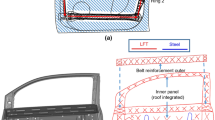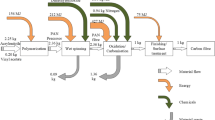Abstract
In this study, life cycle assessment was applied to a novel liquid flow window, based on the cases of sports center application in different climates of Hong Kong and Beijing. The economic, environmental and energy impacts of selected window frame material, the expected lifetime and cost of the working fluid and accessory components were assessed. It was found that the use of wooden frame could be advantageous in that the cost payback time is less than 1.4 years in Hong Kong and well below 5.5 years in Beijing. Nevertheless, when stainless steel frame was in use, the cost payback period would increase to 3.0 and 7.0 years for Hong Kong and Beijing respectively. The lengthy payback time of Beijing is mainly caused by the use of expensive anti-freezer in the liquid circulation. Sensitivity test showed that by taking efforts to lower the material costs and to prolong the lifetime of working liquid, the cost payback time in Hong Kong and Beijing could be reduced to 1.5 and 3.6 years or lower.
Similar content being viewed by others
References
ASHRAE (2013). ASHRAE Handbook—Fundamentals. Atlanta, GA, USA: American Society of Heating, Refrigerating, Air Conditioning Engineer.
Ardente F, Beccali G, Cellura M, Lo Brano V (2005a). Life cycle assessment of a solar thermal collector: Sensitivity analysis, energy and environmental balances. Renewable Energy, 30: 109–130.
Ardente F, Beccali G, Cellura M, Lo Brano V (2005b). Life cycle assessment of a solar thermal collector. Renewable Energy, 30: 1031–1054.
Battisti R, Corrado A (2005). Environmental assessment of solar thermal collectors with integrated water storage. Journal of Cleaner Production, 13: 1295–1300.
Chow TT, Li C, Lin Z (2010). Innovative solar windows for coolingdemand climate. Solar Energy Materials and Solar Cells, 94: 212–220.
Chow TT, Li C, Lin Z (2011a). The function of solar absorbing window as water-heating device. Building and Environment, 46: 955–960.
Chow TT, Li C, Lin Z (2011b). Thermal characteristics of water-flow double-pane window. International Journal of Thermal Sciences, 50: 140–148.
Chow TT, Ji J (2012). Environmental life-cycle analysis of hybrid solar photovoltaic/thermal systems for use in Hong Kong. International Journal of Photoenergy, 2012: 1–9.
Chow TT, Li CY, Clarke JA (2012). Numerical prediction of water-flow glazing performance with reflective coating. In: Proceedings of the 12th International IBPSA Building Simulation Conference, Sydney, Australia.
Chow TT, Lyu Y (2017a). Effect of design configurations on water flow window performance. Solar Energy, 155: 354–362.
Chow TT, Lyu Y (2017b). Numerical analysis on the advantage of using PCM heat exchanger in liquid-flow window. Applied Thermal Engineering, 125: 1218–1227.
Gstoehl D, Stopper J, Bertsch S, Schwarz D (2011). Fluidised glass façade elements for an active energy transmission control. Paper presented at World Engineers Convention, Geneva, Switzerland.
Guo F, Zhang J, Shan M, Yang X (2018). Analysis on the optimum matching of collector and storage size of solar water heating systems in building space heating applications. Building Simulation, 11: 549–560.
Hang Y, Qu M, Zhao F (2012). Economic and environmental life cycle analysis of solar hot water systems in the United States. Energy and Buildings, 45: 181–188.
Kalogirou SA (2004). Environmental benefits of domestic solar energy systems. Energy Conversion and Management, 45: 3075–3092.
Li C, Chow TT (2011). Water-filled double reflective window and its year-round performance. Procedia Environmental Sciences, 11: 1039–1047.
Li Z, Chen H, Lin B, Zhu Y (2018). Fast bidirectional building performance optimization at the early design stage. Building Simulation, 11: 647–661.
Li C, Tang H (2020). Evaluation on year-round performance of doublecirculation water-flow window. Renewable Energy, 150: 176–190.
Liebold A, Oppliger D, Gstöehl D, Menzi T, Bertsch S (2014). Fluid glass-façade element for active solar control for high-rise buildings. In: Proceedings of the 3rd International High-Performance Buildings Conference at Purdue, Purdue, USA.
Lyu Y, Chow TT, Wang J (2018). Numerical prediction of thermal performance of liquid-flow window in different climates with anti-freeze. Energy, 157: 412–423.
Masruroh NA, Li B, Klemeš J (2006). Life cycle analysis of a solar thermal system with thermochemical storage process. Renewable Energy, 31: 537–548.
Mateus T, Oliveira AC (2009). Energy and economic analysis of an integrated solar absorption cooling and heating system in different building types and climates. Applied Energy, 86: 949–957.
Otanicar TP, Phelan PE, Golden JS (2009). Optical properties of liquids for direct absorption solar thermal energy systems. Solar Energy, 83: 969–977.
Schiavoni S, Sambuco S, Rotili A, D'Alessandro F, Fantauzzi F (2017). A nZEB housing structure derived from end of life containers: Energy, lighting and life cycle assessment. Building Simulation, 10: 165–181.
Sekhar SC, Toon KLC (1998). On the study of energy performance and life cycle cost of smart window. Energy and Buildings, 28: 307–316.
Simons A, Firth SK (2011). Life-cycle assessment of a 100% solar fraction thermal supply to a European apartment building using water-based sensible heat storage. Energy and Buildings, 43: 1231–1240.
Stopper J, Boeing F, Gstoehl D (2013). Fluid glass façade elements: Energy balance of an office space with a fluid glass façade. Munich Economic Forum.
Teenou RY (2012). Energy and CO2 emissions associated with the production of multi-glazed windows. Master Thesis. Mid Sweden University, Sweden.
Gil-Lopez T, Gimenez- Molina C (2013a). Environmental, economic and energy analysis of double glazing with a circulating water chamber in residential buildings. Applied Energy, 101: 572–581.
Gil-Lopez T, Gimenez- Molina C (2013b). Influence of double glazing with a circulating water chamber on the thermal energy savings in buildings. Energy and Buildings, 56: 56–65.
Weir G, Muneer T (1998). Energy and environmental impact analysis of double-glazed windows. Energy Conversion and Management, 39: 243–256.
Xie H, Gong G, Fu M, Wang P, Li L (2018). A thermodynamic method to calculate energy & exergy consumption and CO2 emission of building materials based on economic indicator. Building Simulation, 11: 235–244.
Acknowledgements
The work described in this article was financially supported by the National Natural Science Foundation of China (No. 51566014) and the Youth Scholar Program of Xihua University.
Author information
Authors and Affiliations
Corresponding author
Rights and permissions
About this article
Cite this article
Lyu, Y., Chow, Tt. Economic, energy and environmental life cycle assessment of a liquid flow window in different climates. Build. Simul. 13, 837–848 (2020). https://doi.org/10.1007/s12273-020-0636-z
Received:
Revised:
Accepted:
Published:
Issue Date:
DOI: https://doi.org/10.1007/s12273-020-0636-z




